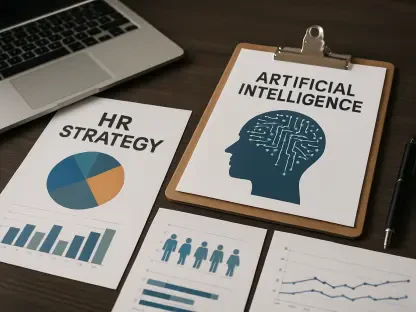Employee onboarding is undergoing a rapid transformation, driven by advanced technologies that are reshaping traditional methods and practices. Virtual Reality (VR) is emerging as a powerful tool in this evolution, offering the potential to create more engaging, interactive, and efficient experiences for new hires. This article explores how VR can revolutionize onboarding processes and ensure a smooth transition for employees into their roles and organizational culture.
Reimagining Traditional Onboarding
Traditional onboarding methods typically involve a mix of paperwork, presentations, and standardized sessions. While these methods provide necessary information, they often fail to engage new hires effectively. Virtual Reality offers an immersive alternative, transforming the learning process into something dynamic and hands-on. VR aims to foster more productive and satisfying onboarding journeys by offering employees practical, real-world experiences of their roles, company culture, and workplace environment. This interactive approach can significantly enhance engagement and retention among new hires.
By immersing new employees in realistic simulations of their future work environments, VR allows them to interact with virtual objects and colleagues in scenarios closely mirroring actual job tasks. This hands-on experience can help them understand their responsibilities more effectively than traditional training manuals or slide presentations. Moreover, VR can simulate workplace scenarios, enabling new hires to get acquainted with the company’s culture and operational protocols without the physical limitations of their immediate surroundings.
In addition to offering practical experiences, VR training programs can be tailored to the unique needs of each employee. By customizing onboarding modules based on individual learning speeds and preferences, VR ensures that employees receive the most relevant and engaging training possible. Personalized learning paths not only enhance knowledge retention but also contribute to a more satisfying and productive onboarding experience. As organizations continue to embrace innovative technologies, VR stands out as a game-changer in transforming traditional onboarding processes into more efficient and engaging journeys for new hires.
The Importance of Innovative Onboarding Solutions
Effective onboarding is crucial for employee engagement and productivity. Research shows that structured onboarding programs can boost retention rates and employee performance by up to 82%. However, traditional methods often leave new hires feeling overwhelmed due to the volume and static nature of the information provided. As the prevalence of remote and hybrid work models continues to grow, the need for innovative onboarding solutions has become even more pronounced. Virtual Reality provides an effective way to meet these evolving demands.
With VR emerging as a key player in modern onboarding practices, it is essential to understand its advantages. Virtual Reality offers immersive, interactive training solutions that significantly enhance employee engagement. Unlike conventional methods, VR can capture an employee’s attention and sustain interest, leading to improved retention of information. Enhanced engagement through VR ensures that new hires are actively involved in the learning process and can fully grasp their roles and responsibilities without feeling overwhelmed.
Moreover, as remote and hybrid work models continue to gain traction, VR can bridge the gap between geographically dispersed employees and standardized onboarding experiences. Virtual Reality allows organizations to provide consistent and inclusive training sessions, regardless of an employee’s physical location. This technology fosters a sense of belonging and integration, enabling remote employees to feel connected to the company’s culture just as effectively as their in-office counterparts. By overcoming geographical barriers and creating uniform onboarding experiences, VR ensures that every new hire receives the same high-quality training, setting the stage for success in their respective roles.
Enhancing Onboarding with VR
Simulating Real-World Scenarios
One of the standout features of VR is its ability to create lifelike work environments. Unlike traditional training methods that rely on manuals or slideshows, VR immerses employees in realistic scenarios where they can interact with objects, colleagues, and tasks. This hands-on experience helps employees better understand their roles and responsibilities. The capacity to simulate real-world scenarios makes VR a particularly effective onboarding tool.
With VR’s immersive capabilities, new hires can practice and hone their skills in a risk-free environment that closely mirrors actual job situations. This approach not only enhances learning outcomes but also builds confidence in new employees as they undertake their real-world duties. Additionally, VR simulations can incorporate various job-specific challenges, allowing new hires to develop problem-solving skills that are essential for success in their roles. By providing practical and realistic training opportunities, VR ensures a smoother transition for employees into their new positions.
Boosting Engagement and Retention
The interactive and immersive nature of VR ensures that employees are actively involved in the learning process. This makes the content more understandable and memorable. In fact, VR learners can retain information up to four times better than those trained through conventional methods. This heightened engagement and information retention can lead to a more productive workforce. VR’s ability to enhance engagement and retention is supported by research, highlighting its effectiveness in transforming onboarding experiences.
By leveraging VR, organizations can provide employees with engaging and memorable training sessions that effectively convey crucial information. This improved retention translates to a more knowledgeable and proficient workforce, capable of performing their roles efficiently. Furthermore, the adaptability of VR allows companies to create customized training modules that cater to varying levels of expertise and learning preferences, ensuring that every employee receives the most relevant and impactful training.
Personalization and Efficiency in Onboarding
Personalized Learning Paths
Every individual has a unique learning pace. VR allows organizations to customize onboarding experiences to meet the specific needs of each new hire. Adaptive VR programs can assess a new employee’s strengths and weaknesses, adjusting training modules accordingly for a tailored learning experience. The ability to personalize training paths ensures that employees receive the most effective and relevant onboarding.
Personalized VR training programs provide a considerate approach to onboarding by acknowledging the diverse learning preferences of new hires. Employees can progress through modules at their own pace, focusing on areas that require more attention while swiftly moving through topics they have already mastered. This personalized approach reduces frustration and enhances overall satisfaction with the onboarding process. By tailoring training sessions to individual needs, VR enables a more efficient and productive pathway for new employees to adapt to their roles seamlessly.
Reducing Training Costs and Time
While the initial investment in VR technology might seem high, it can result in significant long-term cost savings. Traditional onboarding requires travel expenses, printed materials, and instructor-led sessions, which accumulate over time. VR onboarding programs can be reused indefinitely, thereby lowering these recurring costs. Moreover, VR expedites the onboarding process, allowing employees to become productive faster.
In addition to reducing recurring costs, VR onboarding can substantially decrease the time required to bring new employees up to speed with their roles. Interactive VR training modules can be completed more quickly than traditional methods, enabling employees to start contributing to organizational objectives sooner. Reducing training time also translates to higher productivity and faster integration into the team, ultimately benefiting the organization as a whole.
Industry Applications of VR Onboarding
Across Various Sectors
Various industries have recognized the potential of VR for creating immersive and effective onboarding experiences. For instance, the healthcare sector uses VR to practice complex procedures in a safe, simulated environment, boosting confidence and reducing errors. In manufacturing, VR training can help workers learn to operate heavy machinery and stick to safety protocols without real-world risks. By allowing employees to gain practical experience in a controlled setting, VR minimizes the risk of workplace accidents and improves job performance.
The retail industry also leverages VR to help employees familiarize themselves with store layouts and customer interactions before they start their roles. Through virtual simulations, retail workers can practice handling different customer scenarios, ensuring they are well-prepared for real-life interactions. Similarly, finance professionals benefit from VR onboarding by experiencing market fluctuations and trading scenarios through simulations, reducing the risks associated with real-world financial operations.
Enhancing Sector-Specific Skills
Other industries such as tech and software development use VR onboarding to explore coding environments and simulate cybersecurity scenarios. Developers can practice coding in immersive VR setups that allow them to experiment and innovate without real-world constraints. IT teams can benefit from VR simulations of cybersecurity threats, enabling them to develop strategies to thwart potential attacks and enhance their preparedness. This sector-specific training ensures employees possess the necessary skills to handle their roles effectively.
By leveraging VR, companies across various sectors can create more comprehensive and engaging onboarding programs, ensuring that new hires are well-prepared and integrated, regardless of their physical location. The adaptability of VR technology allows for the development of industry-specific training modules, providing employees with practical experiences tailored to their job functions. This targeted approach results in a more competent and confident workforce, ready to excel in their respective roles.
Conclusion
Employee onboarding is currently experiencing a dramatic shift, driven largely by the advent of sophisticated technologies which are revolutionizing traditional approaches and practices. Among these innovations, Virtual Reality (VR) is taking the lead as a highly effective tool, showing immense promise in making onboarding for new hires more engaging, interactive, and efficient. This immersive technology has the capability to transform how companies introduce their employees to their roles and organizational culture, ensuring a smoother transition and better preparedness on the part of the new hires. By leveraging VR, businesses can simulate real-world scenarios and environments that new employees are likely to encounter, thereby offering a more realistic and hands-on orientation experience. This article delves into the potential VR holds for revolutionizing onboarding processes, making it easier for new employees to adapt quickly and effectively, thus enhancing retention rates and overall job satisfaction. VR isn’t just a trend; it’s reshaping the future of employee integration.









